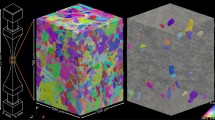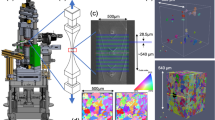Abstract
This additive manufacturing benchmarking challenge asked the modeling community to predict the stress–strain behavior and fracture location and pathway of an individual mesoscale (gauge dimensions of approximately 200 µm thickness, 200 µm width, 1 mm length) tension specimen that was excised from a wafer of nickel alloy IN625 manufactured by laser powder bed fusion (L-PBF). The data used for the challenge questions and answers are provided in a public dataset (https://data.nist.gov/od/id/mds2-2587). Testing models against the data is still possible, although a good-faith blinded prediction should be attempted before reading this article, as the results are contained herein. The uniaxial tension test was pin loaded, conducted at quasi-static strain rates under displacement control, and strain was measured via non-contact methods (digital image correlation). The predictions are challenging since the number of grains contained in the thickness of the specimen is subcontinuum. In addition, pores can be heterogeneously distributed by the L-PBF process, as opposed to intentionally seeded defects. The challenge provided information on chemical composition, grain and sub-grain structure (surface-based measurements via electron backscatter diffraction and scanning electron microscopy) and pore structure (volume-based measurements via X-ray computed tomography) along the entire gauge length for the tension specimen. During the challenge, prediction responses were collected from six different groups. Prediction accuracy compared to the measurements varied, with elastic modulus and strain at ultimate tensile strength consistently over-predicted, while most other values were a mix of over- and under-predicted. Overall, no one model performed best at all predictions. Failure-related properties proved quite challenging to predict, likely in part due to the data provided as well as the inherent difficulty in predicting fracture. Future directions and areas of improvement are discussed in the context of improving model maturity and measurement uncertainty.










Similar content being viewed by others
Data Availability
All data are published at [12]. Materials are all available to the public and have been as thoroughly identified as possible to facilitate reproduction of the work.
Code Availability
Code and some raw data have been shared in [11] and [12]. Commercial codes (e.g., EBSD analysis) have been identified where possible. Code and some raw data for DIC data processing (strain measurement) have been withheld for legal reasons (see [9]), although devising a way to publish these codes is under way.
Notes
Certain commercial equipment, instruments, or materials are identified in this paper in order to specify the experimental procedure adequately. Such identification is not intended to imply recommendation or endorsement by NIST, nor is it intended to imply that the materials or equipment identified are necessarily the best available for the purpose.
This commercial test stage was manufactured in the 1990s to early 2000s, and documentation on its specifications is scarce as the vendor no longer exists.
References
Gesing M, Gilkey LN, Jones CA, Dingreville R, Sanborn SE, Bignell JL, Cerrone AR, Keim V, Nonn A, Cooreman S, Thibaux P, Ames N, Connor DO, Parno M, Davis B, Tucker J, Coudrillier B, Karlson KN, Ostien JT, Foulk JW, Hammetter CI, Grange S, Emery JM, Brown JA, Bishop JE, Johnson KL, Ford KR, Brinckmann S, Neilsen MK, Jackiewicz J, Ravi-Chandar K, Ivanoff T, Salzbrenner BC, Boyce B (2019) The third sandia fracture challenge: predictions of ductile fracture in additively manufactured metal. Int J Fract 218:105. https://doi.org/10.1007/s10704-019-00361-1
Cox ME, Schwalbach EJ, Blaiszik BJ, Groeber MA (2021) AFRL additive manufacturing modeling challenge series: overview. Integr Mater Manuf Innov 10:12564. https://doi.org/10.1007/s40192-021-00215-6
Levine L, Lane B, Heigel J, Migler K, Stoudt M, Phan T, Ricker R, Strantza M, Hill M, Zhang F, Seppala J, Garboczi E, Bain E, Cole D, Allen A, Fox J, Campbell C (2020) Outcomes and conclusions from the 2018 AM-bench measurements, challenge problems, modeling submissions, and conference. Integr Mater Manuf Innov 9(1):1–15. https://doi.org/10.1007/s40192-019-00164-1
Committee AE (2016) ASTM E1479-16: standard practice for describing and specifying inductively coupled plasma atomic emission spectrometers. https://doi.org/10.1520/E1479-16
Committee AE (2018) ASTM E1019-18: Standard test methods for determination of carbon, sulfur, nitrogen, and oxygen in steel, iron, nickel, and cobalt alloys by various combustion and inert gas fusion techniques. https://doi.org/10.1520/E1019-18
Committee AB (2022) ASTM B564-22: Standard specification for nickel alloy forgings. https://doi.org/10.1520/B0564-22
Liew L-A, Read DT, Martin ML, DelRio FW, Bradley PE, Barbosa N, Christenson TR, Geaney JT (2020) Elastic-plastic properties of mesoscale electrodeposited LIGA nickel alloy films: microscopy and mechanics. J Micromech Microeng 31(1):15002. https://doi.org/10.1088/1361-6439/abc0ff
Benzing JT, Liew LA, Hrabe N, DelRio FW (2020) Tracking defects and microstructural heterogeneities in meso-scale tensile specimens excised from additively manufactured parts. Exp Mech 60(2):165–170. https://doi.org/10.1007/s11340-019-00558-4
Liew L-A, Read DT, Martin ML, Christenson TR, Geaney JT (2021) Microfabricated fiducial markers for digital image correlation-based micromechanical testing of LIGA Ni alloys. Eng Res Express 3(2):025019. https://doi.org/10.1088/2631-8695/abfb10
Liew L-A, Read DT, Martin ML, Bradley PE, Geaney JT (2023) Elastic-plastic properties of mesoscale electrodeposited LIGA nickel alloy films: analysis of measurement uncertainties. J Verificat Validat Uncert Quantif 8(1):011005. https://doi.org/10.1115/1.4062106
Moser NH, Landauer AK, Kafka OL (2023) Image processing in Python for 3D image stacks (Imppy3d). National Institute of Standards and Technology. https://doi.org/10.18434/mds2-2806
AM Bench 2022 challenge problem Subcontinuum Mesoscale Tensile Test (CHAL-AMB2022-04-MeTT). National Institute of Standards and Technology. https://doi.org/10.18434/mds2-2587
Zhang F, Levine LE, Allen AJ, Young SW, Williams ME, Stoudt MR, Moon K-W, Heigel JC, Ilavsky J (2019) Phase fraction and evolution of additively manufactured (AM) 15–5 stainless steel and inconel 625 AM-bench artifacts. Integr Mater Manuf Innov 8(3):362–377. https://doi.org/10.1007/s40192-019-00148-1
Phan TQ, Strantza M, Hill MR, Gnaupel-Herold TH, Heigel J, D’Elia CR, DeWald AT, Clausen B, Pagan DC, Peter Ko JY, Brown DW, Levine LE (2019) Elastic residual strain and stress measurements and corresponding part deflections of 3D additive manufacturing builds of IN625 AM-bench artifacts using neutron diffraction, synchrotron X-ray diffraction, and contour method. Integr Mater Manuf Innov 8(3):318–334. https://doi.org/10.1007/s40192-019-00149-0
Lee PL, Shu D, Ramanathan M, Preissner C, Wang J, Beno MA, Von Dreele RB, Ribaud L, Kurtz C, Antao SM, Jiao X, Toby BH (2008) A twelve-analyzer detector system for high-resolution powder diffraction. J Synchrotron Rad 15(5):427–432. https://doi.org/10.1107/S0909049508018438
Williamson GK, Smallman RE (1956) III dislocation densities in some annealed and cold-worked metals from measurements on the X-ray debye-scherrer spectrum. Philosoph Magaz J Theoret Experim Appl Phys 1(1):34–46. https://doi.org/10.1080/14786435608238074
Wang Z, Stoica AD, Ma D, Beese AM (2016) Diffraction and single-crystal elastic constants of Inconel 625 at room and elevated temperatures determined by neutron diffraction. Mater Sci Eng A 674:406–412. https://doi.org/10.1016/j.msea.2016.08.010
AM Bench 2022 challenge Macroscale Tensile Tests at Different Orientations (CHAL-AMB2022-04-MaTTO). National Institute of Standards and Technology. https://doi.org/10.18434/mds2-2588
Acknowledgements
We thank Lyle Levine for coordinating and running the overall AM Benchmark series, of which this was part.
Funding
NIST provided all funding needed for this research.
Author information
Authors and Affiliations
Contributions
OLK contributed to conceptualization and design, experiments (XRCT), and analysis and writing/editing; JTB contributed to conceptualization and design, sample preparation, experimentation (SEM and EBSD), and writing/editing; NM contributed to conceptualization and design, and experimentation (XRCT); LAL was involved in sample design, mechanical testing, and data analysis; JW contributed to conceptualization and part fabrication; and NH was involved in conceptualization and design, project management, and organization.
Corresponding authors
Ethics declarations
Conflict of interest
On behalf of all authors, the corresponding author states that there is no conflict of interest.
Ethics Approval
This work has been reviewed by the NIST Editorial Review Board and found acceptably for publication.
Consent for Publication
All authors have read and agreed to the contents of this manuscript.
Additional information
Official contribution of the National Institute of Standards and Technology; not subject to copyright in the United States.
A DIC Parameters
A DIC Parameters
Table 6 reports the relevant DIC parameters used for 2-point extensometry style strain measurement.
Rights and permissions
About this article
Cite this article
Kafka, O.L., Benzing, J., Moser, N. et al. Additive Manufacturing Benchmark 2022 Subcontinuum Mesoscale Tensile Challenge (CHAL-AMB2022-04-MeTT) and Summary of Predictions. Integr Mater Manuf Innov 12, 196–209 (2023). https://doi.org/10.1007/s40192-023-00307-5
Received:
Accepted:
Published:
Issue Date:
DOI: https://doi.org/10.1007/s40192-023-00307-5




